Prosperity Hinges on Health Security
Advocates for global health security hoped that the 2014 West African Ebola outbreak would be the game changer that would finally spur meaningful, coordinated investment in health security—and break the recurrent cycle of panic and neglect towards epidemics.
Indeed, in the immediate aftermath it did. The Ebola outbreak led to multi-country commissions, coordinating mechanisms, and expanded public financing such as creation of the Oslo Commission, the Global Health Security Agenda (GHSA), and the World Bank’s Pandemic Emergency Financing (PEF) Facility, to name a few. Individual countries and sub regions also intensified investments in prevention, detection, and response to epidemic threats. Yet today, we risk undoing these health security “wins.” In a world with no dearth of global challenges or domestic health issues to address, why should countries, in particular bilateral donor countries, care about preventing epidemic threats in other countries? The moral argument is clear-cut: Epidemics cost lives—in some countries, much more than others. Some of the most epidemic-prone countries are the least prepared to address epidemic threats. However, moral arguments are not always the most effective means to sway policy makers, as highlighted by the recent drop in bilateral investments in global health security. With complacency creeping up, and the scaling back of bilateral support for “hotspot country” disease surveillance and preparedness programs, we once again face a heightened risk for another pandemic.
In this climate, there is a pressing need to strengthen the investment case for health security. The global goods aspect of health security has been stressed before. Not to mention that preemptive control of epidemics at source is both cost-effective and our best bet for epidemic risk reduction worldwide. Moreover, there is compelling evidence that epidemics can push back years of progress in development gains, as was seen with the Ebola-affected countries. It is estimated that a “moderate pandemic” could cost the global economy annually over $570 billion or 0.7% of global GDP, while a “severe” pandemic like the 1918 flu could lead to global losses of up to $6 trillion, not to mention the 50-100 million lives lost. The sheer scale of potential pandemic-related economic loss makes it essential that the investment case for preparedness is made not just to policy makers but also to policy influencers and power-brokers at community, country, regional, and global levels. This requires government at all levels, the private sector, NGOs, and health professionals to be aware of the prospects of mutual gains or losses from action and inaction.
Which brings us to the “How?” Last month, when the economically powerful and leaders from many countries came together at the World Economic Forum (WEF) in Davos, Switzerland, pandemics were on the agenda. The previous year saw progress with the unveiling of a new Coalition for Epidemic Preparedness Innovation (CEPI)—a multi-million-dollar, public-private partnership for vaccine research to address emerging infectious threats. CEPI and the WEF pandemic discussion were good starts, but global health security needs to be a permanent WEF agenda item. More than discussion, building on the CEPI example, the WEF objective should be to discuss, define, and devise coordinated and innovative action across the prevention, detection, and response spectrum.
Bankers and investment managers, insurance companies, private sector entrepreneurs (big and small), rich and poorer countries are each, to varying degrees, economically vulnerable to infectious disease impacts—whether homegrown or emerging elsewhere. For example, a recent study highlighted how epidemics in other countries can damage the US economy considerably by disrupting trade and curbing US exports. An epidemic that remains outside the US could still cost the country up to $18 billion a year and place 1.4 million US jobs at-risk, according to a recent study. An infectious disease outbreak in Southeast Asia, for example, would disrupt critical supply and distribution chains, and affect the availability of raw and processed materials needed by developed countries as well as the provision of goods and services. Had the 2015 Middle East Respiratory Syndrome (MERS) outbreak not been contained quickly in South Korea, the impact would have been extensive and felt worldwide. For South Korea, the cost was estimated at $2 billion, including direct, indirect and “fearonomic effects.” We can only speculate what would have been the cost had a MERS outbreak occurred during the winter Olympics.
Simply put, global health security needs to be on the agenda, alongside other prospective economic impact issues for the 21st century, and risks to jobs, cross border trade, and economic growth. Global financial stakeholders must proactively acknowledge the critical links between economic prosperity and global health security. Before the powerful men and women return to Davos for the next WEF, we hope to see a place reserved for the economic risks from infectious threats. The overarching message is clear—outbreaks, whether they happen at home or abroad, pose a threat to economies everywhere.
Sulzhan Bali (@sulzhan) is an independent consultant specializing in global health security.**
Richard Seifman is a member of the Global Fund to Fight AIDS, TB and Malaria Technical Review Panel and a board member of the National Physicians Alliance.**
**The views in this article are authors’ alone and do not represent the views of the organizations with whom they work.
Join the tens of thousands of subscribers who rely on Global Health NOW summaries and exclusive articles for the latest public health news. Sign up for our free weekday enewsletter, and please share the link with friends and colleagues: http://www.globalhealthnow.org/subscribe.html
iStock




